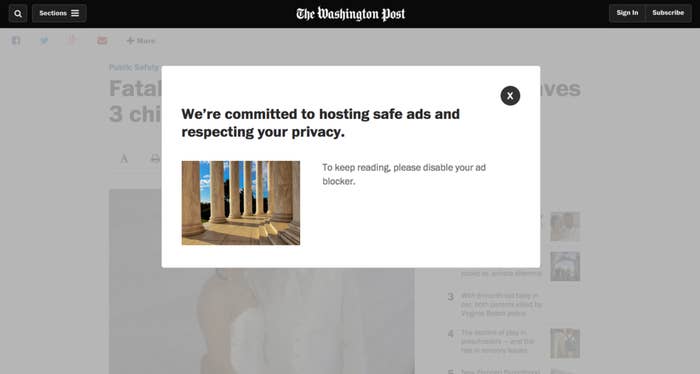
It starts with a gentle nudge and ends with a hard block and a demand for cash. The Washington Post has begun intermittently redirecting desktop users to a subscription page if they are using the popular AdBlock software, some readers have reported.
In one case, using Chrome with AdBlock on, the Post had a dialog box redirecting users to enter their email for a free six week subscription. The anti-AdBlock measures don't seem comprehensive just yet — we were able to view articles after clicking through from a search results link in Firefox with the ad blocking software turned on. But when we clicked through to another article on the site, the redirect screen popped up.

Another user saw the subscription redirect when they clicked on a link from the Post's Facebook page. They also saw another pop-up informing them that to keep reading, they would need to disable the ad blocker.
NOPE × 999999 × 10^23
The Twitter user above got a dialog box asking them to subscribe to an email newsletter to "unlock" the story. When he clicked on the same link later, he was able to read it.
"Many people already receive our journalism for free online, with digital advertising paying only a portion of the cost," a Washington Post spokesperson told BuzzFeed News.
"Without income via subscriptions or advertising, we are unable to deliver the journalism that people coming to our site expect from us. We are currently running a test using a few different approaches to see what moves these readers to either enable ads on The Washington Post, or subscribe."
There's a kind of Cold War brewing between publishers who say that ad blocking software cuts off the lifeblood of free media online, and readers who complain about pages crammed with garish ads and intrusive trackers, which make many sites bloated and slow to load.
That conflict is reaching new heights as it moves to mobile devices, where the bulk of todays web audiences are. The popular AdBlock Plus software is becoming available on mobile, and Apple is introducing features in its mobile operating system that will let developers more easily create ad blockers for its Safari mobile web browser.
